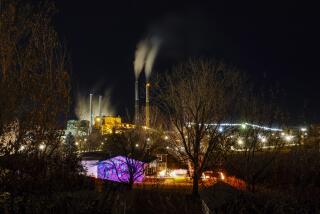âThe Last Best Placeâ in America : RIDE WITH ME, MARIAH MONTANA <i> By Ivan Doig (Atheneum: $18.95; 384 pp.; 0-689-12019-2) </i>
When does a farmer or rancher finally give up on making a living from his land and sell out to some distant corporation or resign himself to foreclosure? When does the small-town grocer, undercut by malls, do the same? And what about the young people in rural America, whose best prospects lie in the big cities? What happens to our collective spirit when we pull up roots and dissolve communities, when families find themselves separated?
âHow and when should we leave our own roots?â each of the main characters in Ivan Doigâs new novel asks. In doing so, they voice an issue on the minds of many Americans.
âRide With Me, Mariah Montanaâ is the last volume of Doigâs Montana trilogy, which covers 100 years of Montana history as viewed through the eyes of the fictional McCaskills, a Scottish immigrant ranching family. The first volume, âEnglish Creekâ (1984), was set in the 1880s when the first McCaskills arrived in Montana. The second volume, âDancing at the Rascal Fairâ (1987), took place during the Depression years. Last year, Montana celebrated its centennial, an event that provided the perfect theme and setting for the concluding story about the McCaskills, in which a father and daughter set out in a Winnebago during the centennial summer in order to âget the true storyâ of the state.
Jick McCaskill, a recently widowed rancher, is talked into making this journey by his daughter Mariah, a photographer for a newspaper that has assigned her to do a series on the centennial. Joining them is Mariahâs ex-husband, Riley Wright, a wise-cracking reporter who is to provide the text for Mariahâs pictures. Jick, Mariah and Riley--a reconstituted family largely at odds with each other--set out in the mobile home, crisscrossing the state in search of stories.
The novel has a lively tone and a quick pace. Doig has a perfect ear for colloquial speech, and he is both eloquent (in passages where he simulates Rileyâs journalism) and funny (when he sets the trio to verbal sparring). They encounter old-timers as well as new immigrants such as the Vietnamese waiter enthusiastically struggling with the new language. The trio visits historical monuments, battlefields and preserves where they gaze wistfully at the remaining buffalo--once so thick âthe country was one robe.â Inevitably their own personal histories unfold. The trip jars memories, of Riley and Mariahâs acrimonious divorce, of Jickâs own unhappy first marriage and his deeply satisfying second one.
Doig uncovers both the beautiful and the tattered sides of Montana: the dump heaps and earth poisons left by strip mining; the mobile missiles--âblue taxis to Armageddonâ (there are 200 Minuteman missile silos across Montana). He writes of the defeated lives on Indian reservations, and the âbottom-wage way of lifeâ that drives young people elsewhere.
But he also celebrates the beauty of the land and the tenacity of spirit found in Montanans âwhoâve been perpetually game to outwork the levels of pay here because they can love a mountain with their eyes while doing it,â people who see life as âan up-and-down proposition.â In the great expanse of Montana, man is given âmuch room and inclination to do both our worst and our best.â
The question of how and when to leave oneâs roots becomes more pressing as the journey progresses. Jick, who has left his sheep ranch in the hands of caretakers, must decide what to do with an operation he can no longer manage alone and which neither of his children wants to take over. Riley and Mariah, who have effected a tumultuous reconciliation, begin planning to move to the West Coast once the centennial is over. The future hangs in the balance: Will the last McCaskills leave the land or find a way to remain rooted in what has become known as âthe last best placeâ?
In certain ways, Montana has come to embody whatâs left of the âWestâ as it once was known. But the history of the American West was written as a romance, and the romance has run its course. A more shameful picture has emerged, a story of despoliation and genocide, of exploitation, corruption and greed. As America enters the 21st Century, the West looks more and more like a big theme park. The outdoors has become little more than a backdrop for commercial, recreational activity.
Doig understands these issues better than most. He has steeped himself in Western history and written the sorts of books that donât romanticize the experience as much as present it in small-scale, human terms. He has written beautifully and with tenderness and humor of simple people who love the soil.
In the long run, all the âsad behaviorâ of man over the last hundred years canât erase hope for the future. Jick McCaskill doesnât sell out but manages to find a way to ensure that his ranch will pass to future generations in an unspoiled condition. Even Mariah recants on California and makes a continuing commitment to her roots, thus affirming the McCaskillsâ attachment to the soil.
It seemed right that âRide With Me, Mariah Montanaâ should have ended on such a hopeful note. After all, Ivan Doig is the most hopeful of writers--not blindly optimistic but deeply humanistic. âHe who owns the soil,â he has written, âowns up to the sky.â
In Montana, thatâs a big piece of heaven, something worth hanging on to.
More to Read
Sign up for our Book Club newsletter
Get the latest news, events and more from the Los Angeles Times Book Club, and help us get L.A. reading and talking.
You may occasionally receive promotional content from the Los Angeles Times.








